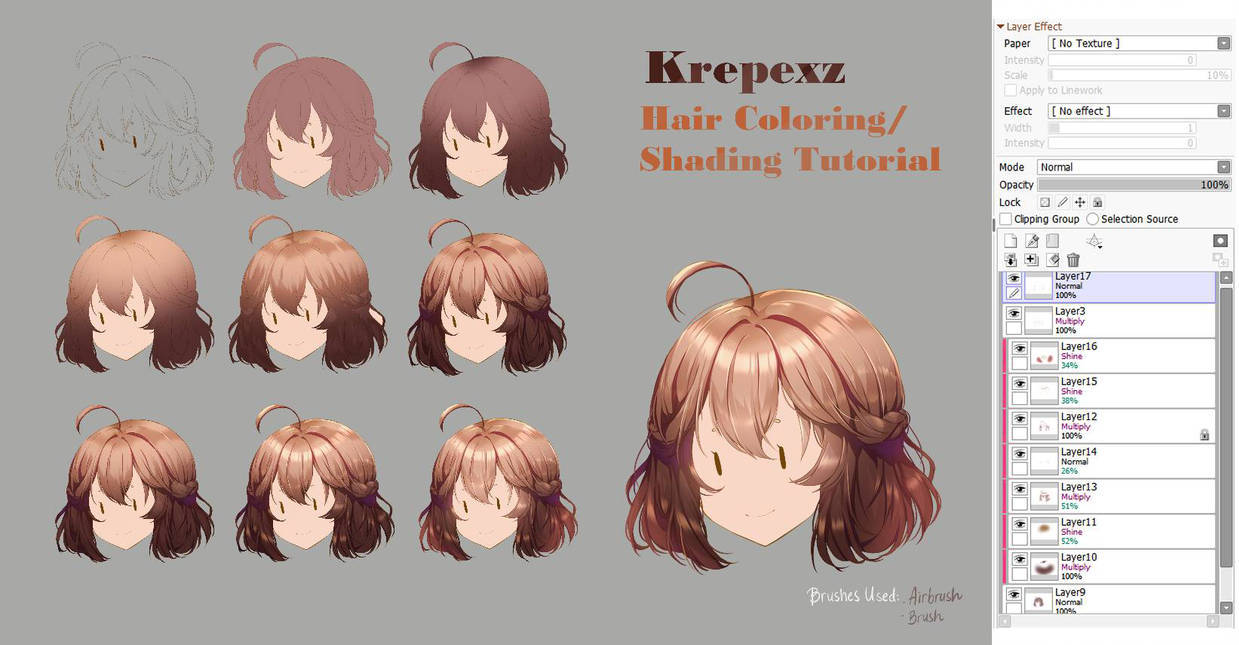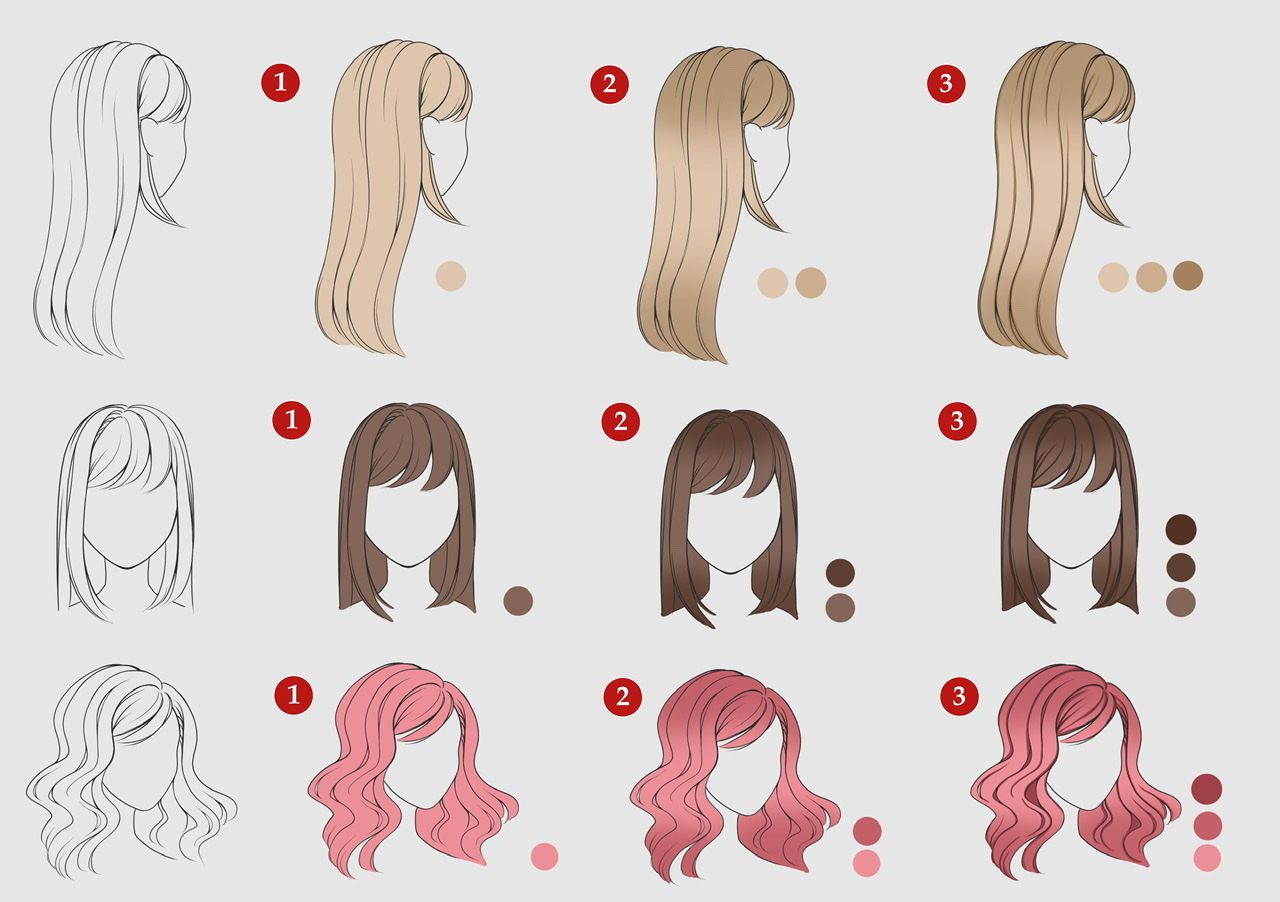Remember that time you tried to dye your hair at home and ended up with streaks of orange instead of the beautiful auburn you envisioned? We’ve all been there. Coloring your hair can be a transformative experience, offering a chance to express your individuality and reinvent your look. But achieving professional salon-worthy results at home can feel like an impossible feat. Fear not, aspiring hair colorists! This guide will walk you through the process of coloring your hair like a pro, ensuring a flawless result that leaves you feeling confident and beautiful.

Image: drawingden.tumblr.com
From choosing the right shade to mastering the application technique, we’ll break down each step into manageable chunks, ensuring you can achieve salon-quality color without having to step foot in a salon. So grab your gloves, gather your supplies, and let’s dive into the world of at-home hair coloring!
Choosing the Right Hair Color
The foundation of a successful hair color transformation lies in picking the perfect shade. This can be a daunting task, with countless options ranging from vibrant hues to natural tones. To make this process easier, consider your natural hair color, skin tone, and desired outcome. If you’re unsure about which shade to choose, consult a hair color chart or seek professional advice from a hairstylist. They can help you identify a shade that complements your features and enhances your natural beauty.
When selecting your hair color, consider the level (lightness or darkness) and tone (warm, cool, or neutral). A level 1 is the darkest black, while a level 10 is the lightest blonde. Tones can create a vibrant, cool, or warm effect. Understanding these elements will help you choose a color that not only looks great but also flatters your skin tone.
Preparing for Your Hair Color Transformation
Before you jump into the coloring process, it’s essential to prepare your hair and skin properly. This ensures a smooth and successful application, preventing any unwanted mishaps. Start by washing your hair with a clarifying shampoo to remove any product buildup or residue. This ensures the color adheres evenly to your hair strands and produces a consistent result.
Next, apply a thin layer of petroleum jelly along your hairline and ears (or any area where you don’t want the color to touch). This acts as a barrier, preventing the color from staining your skin. Once your skin is protected, gather your hair coloring tools. These usually include a bowl, brush, gloves, and an old towel to prevent staining your clothes.
Mixing and Applying the Hair Color
With your tools and preparation in place, you’re ready to mix and apply the hair color. Most at-home hair coloring kits come with everything you need, including the developer, colorant, and instructions. Follow the manufacturer’s instructions carefully. Start by mixing the colorant and developer in a bowl. Blend the mixture thoroughly, ensuring a uniform consistency.
Once the color is mixed, begin applying it to your hair. Start from the roots and work your way down to the ends. Use sections to ensure all hair strands are evenly coated. Apply the color to the roots first. This is usually the most challenging part of the process, so take your time and be thorough.
Once your roots are completely covered, move onto the rest of your hair. Work in sections and apply the color evenly. Be sure to saturate each section thoroughly. If you’re applying the color to your entire head, use a mirror to ensure you don’t miss any spots. Once you’ve applied the color to all of your hair, cover your head with a plastic cap and leave it on for the amount of time specified on the instructions.

Image: thptnganamst.edu.vn
Rinsing and Maintaining Your New Look
After the designated processing time, rinse your hair thoroughly until the water runs clear. You’ll likely find a lot of color coming out, but don’t be alarmed. This is normal. Once you’ve rinsed your hair, apply the color-safe conditioner included in the kit. This helps to seal in the color and keep it looking fresh.
After coloring your hair, it’s important to maintain its vibrancy and health. Use color-safe shampoo and conditioner to help prevent fading and keep your hair hydrated. Avoid washing your hair too frequently, as this can strip away the color. When styling your hair, use heat protectant products to prevent damage from heat styling tools.
For a more vibrant color, consider a color-enhancing shampoo or conditioner to refresh your color between salon visits. It’s also a good idea to keep your hair out of direct sunlight for extended periods as this can cause fading.
Tips and Expert Advice from a Blogger
From a seasoned blogger who has experimented with countless shades and styles, here are some insider tips to elevate your at-home coloring experience:
Choosing the Right Shade
- Always consult a hair color chart before you begin. It’s an invaluable tool for visualizing how different shades will look against your skin tone.
- Select a shade that is no more than two levels lighter or darker than your natural hair color. Going for a drastic color change can lead to unexpected results, especially if you’re new to coloring your hair.
Mixing and Applying the Color
- Use a mixing bowl and brush to apply the color. You should be able to find these at most drugstores or beauty supply stores.
- Always have a timer handy to keep track of the processing time. You can easily find a timer app on your smartphone.
Maintaining Your Color
- Use color-safe shampoo and conditioner to help prevent fading.
- Use a deep conditioner once a week to keep your hair hydrated.
- If you’re using an at-home hair color, make sure you use it according to the instructions on the box.
General FAQs About Hair Coloring
Q: How often should I color my hair?
A: It depends on the type of color you choose. Permanent hair colors typically last for four to six weeks. Semi-permanent hair colors last for two to four weeks. If you have gray hair you may need to color your hair more often, every 3-4 weeks, to touch up your roots.
Q: What is the difference between permanent and semi-permanent hair color?
A: Permanent hair color contains an ammonia and peroxide mixture that lifts and deposits pigment. It creates a long-lasting change, but it’s difficult to remove. Semi-permanent hair colors deposit pigment without lifting the natural hair color. They last for several washes but fade gradually.
Q: What are the risks of coloring my hair at home?
A: Coloring your hair at home can be risky if you don’t follow the instructions carefully. You could end up with uneven color, damage your hair, or even have a chemical reaction on your scalp. If you’re unsure about anything, consult a hairstylist or colorist.
Q: What should I do if I don’t like the color of my hair?
A: Don’t panic! The best course of action is to consult a professional stylist. They can help you correct the color and get your hair back on track.
How To Color Hair Professionally Step By Step
Conclusion
At-home hair coloring can be a rewarding experience, enabling you to transform your look and unleash your creativity. Remember, preparation is key. Carefully selecting the right color, meticulously following the instructions, and using the right products can make all the difference between a successful haircolor transformation and a color disaster. So gather your supplies, embrace the process, and let your creativity shine!
Are you interested in professional hair coloring? What are some of the concerns or questions you have about this process? Share your thoughts in the comments below.



/GettyImages-173599369-58ad68f83df78c345b829dfc.jpg?w=740&resize=740,414&ssl=1)


